Market segmentation is a powerful strategy that allows businesses to divide a broad consumer or business market into sub-groups based on shared characteristics. This targeted approach enables companies to cater to the specific needs of different segments, leading to more effective marketing campaigns and better customer satisfaction. In this comprehensive guide, we will delve into the detailed content of market segmentation, explore its types with examples, and discuss how to create segmented market examples.
What is Market Segmentation and Examples?

Try Market Segmentation for Free
Market segmentation is a strategic marketing approach that involves dividing a broad consumer or business market into smaller, more manageable groups of individuals or organizations with shared characteristics. This method allows businesses to tailor their products, services, and marketing efforts to meet the specific needs of different segments, thereby improving customer satisfaction and increasing marketing effectiveness.
Market segmentation example is based on the recognition that not all customers are alike. By understanding and analyzing the differences and similarities among potential customers, businesses can group them into segments that are internally homogeneous and externally heterogeneous. Each segment is distinct and responds differently to various marketing strategies and stimuli.
What are the 4 Types of Market Segmentation with Examples?
Market segmentation can be broadly categorized into four main types: geographic, demographic, psychographic, and behavioral. Each type has its unique characteristics and benefits, as illustrated by the following examples:

1. Geographic Segmentation
This type of segmentation divides the market based on geographical areas such as countries, regions, cities, or neighborhoods. For instance, a global food and beverage company might offer spicy flavors in regions where spicy food is popular, and milder options in areas where it is not.
Example: A fast-food chain like McDonald's customizes its menu to cater to local tastes and preferences. In India, for instance, McDonald's offers vegetarian options like the McAloo Tikki, which caters to the dietary habits of the local population.
Benefit: Helps businesses tailor their offerings to meet regional demands and cultural preferences, enhancing customer satisfaction and loyalty.
2. Demographic Segmentation
This segmentation is based on demographic factors such as age, gender, income, education, and occupation. For example, a luxury car manufacturer might target high-income individuals, while an affordable clothing brand might focus on young adults and teenagers.
Example: A skincare brand like Nivea offers different product lines for men and women, addressing the distinct skincare needs of each gender. They also have products for different age groups, such as anti-aging creams for older consumers.
Benefit: Enables companies to design targeted marketing campaigns that resonate with specific demographic groups, improving marketing efficiency and effectiveness.
3. Psychographic Segmentation
The psychographic Segmentation approach considers psychological aspects such as lifestyle, values, attitudes, and personality traits. For instance, a company selling outdoor adventure gear might target customers who are adventurous and enjoy outdoor activities.
Example: Nike targets athletes and fitness enthusiasts with its "Just Do It" campaign, which aligns with the values and lifestyle of its target audience. They also sponsor sports events and athletes to reinforce their brand message.
Benefit: Allows businesses to connect with customers on a deeper emotional level by aligning with their values, attitudes, and interests.
4. Behavioral Segmentation
This type segments the market based on consumer behaviors, such as purchasing habits, brand loyalty, usage rates, and benefits sought. For example, a software company might offer different pricing plans for casual users, professional users, and enterprise clients.
Example: Amazon uses purchase history and browsing behavior to recommend products to customers. They segment their market based on buying behavior, such as frequent buyers, occasional buyers, and first-time buyers.
Benefit: Helps businesses create personalized marketing strategies and offers, enhancing customer experience and increasing conversion rates.
Free Market Segmentation Templates
Market Segmentation of Coca-Cola
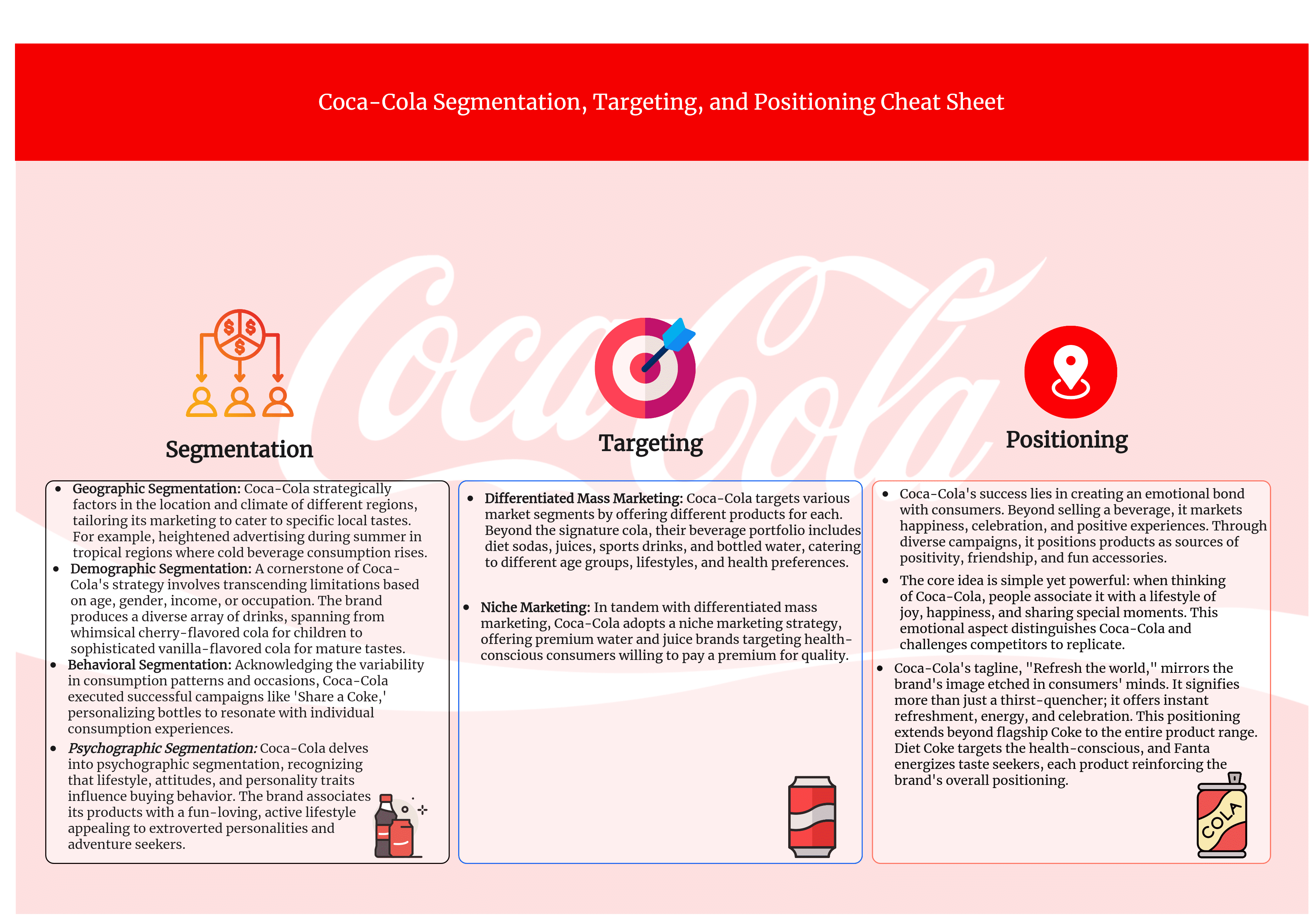
In the vast and intricate world of marketing, market segmentation forms the backbone of any successful marketing strategy. It is the process of subdividing a large, heterogeneous market into identifiable segments with similar needs, wants, or demand characteristics. The essence is to better tailor marketing efforts to meet the needs of these segments. It is in this area that Coca-Cola truly excels. Their approach to market segmentation is a prime example of understanding consumer profiles and enhancing their buying experience.
Market Segmentation of McDonald's
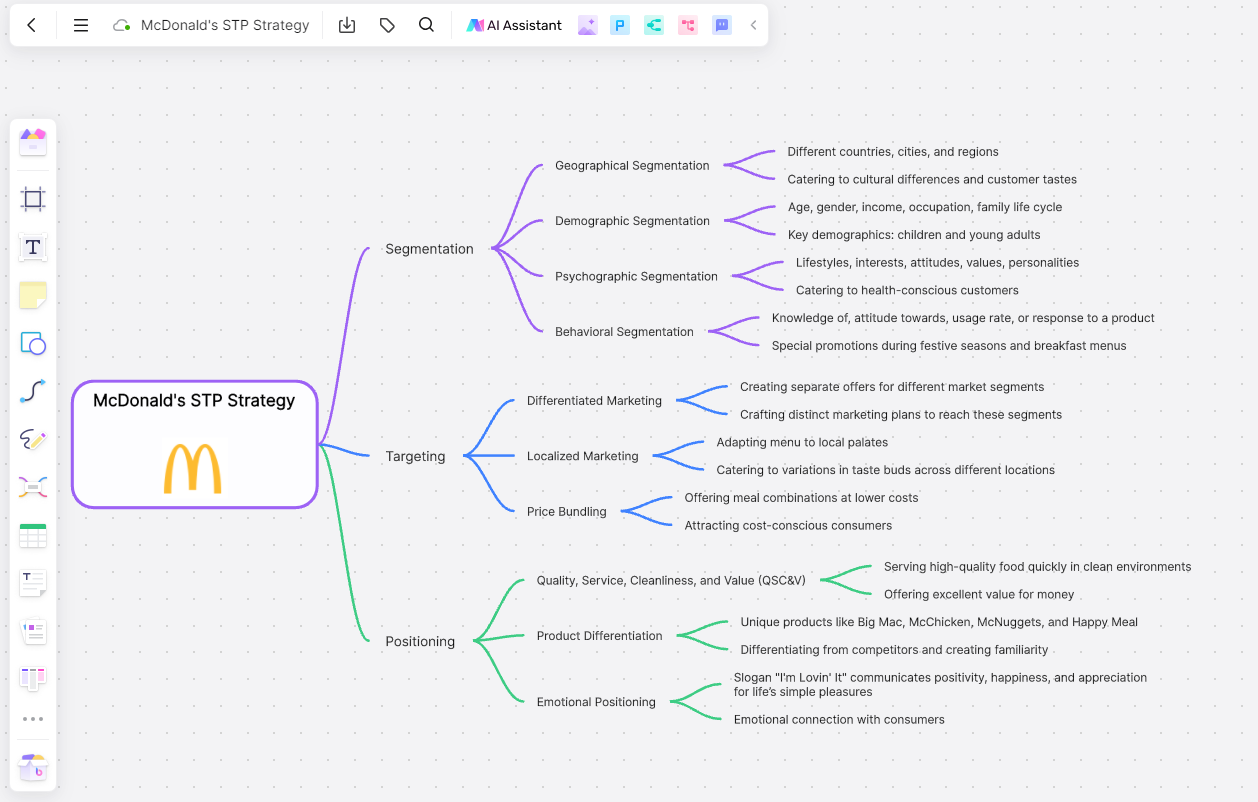
McDonald's market segmentation is undeniably one of the major factors contributing to its international dominance in the fast-food industry. It recognizes the varied needs, preferences, and expectations of consumers across different markets, consequently adopting strategies to cater to these distinctive customer groups. Let’s delve into this intricate strategy by understanding how McDonald's segments its market based on geographical, demographic, psychographic, and behavioral factors.
Market Segmentation of Tesla
Tesla’s segmentation strategy is multifaceted and takes into account a range of demographic, geographic, psychographic, and behavioral variables. Tesla also targets the business segment to sell its electric semi-trucks, energy storage (Powerpacks), and solar products. These are corporations that are eager to embrace sustainable energy solutions as part of their corporate responsibility or due to the cost-saving potential of renewable energy solutions.
How to Create a Segment Market Examples?
Creating a segmented market involves a systematic approach to identifying and analyzing different segments within your target audience. Here’s a step-by-step guide to creating segment market examples:
1. Identify the Market
Define the broad market for your product or service. This could be based on industry, geography, or a specific consumer group.
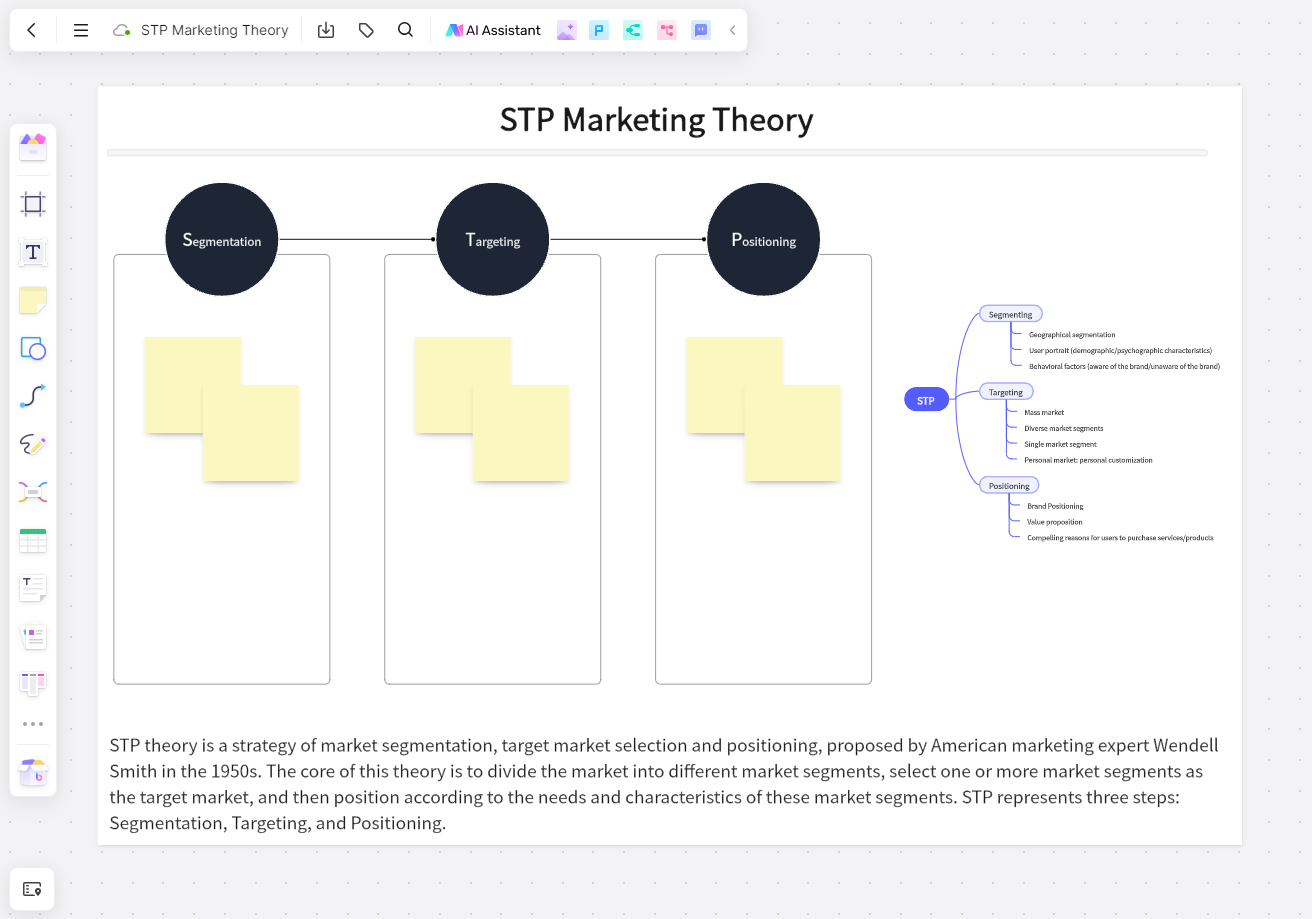
2. Research and Data Collection
Gather data on potential customers using surveys, interviews, focus groups, and market research reports. Look for patterns and common characteristics that can help in segmenting the market.
Boardmix offers various templates for market research, such as surveys, questionnaires, and interview guides. Use these templates to gather data on potential customers. For example, you can create a survey to understand customer preferences, behaviors, and demographics.
3. Choose Segmentation Criteria
Decide on the criteria for segmentation, such as geographic, demographic, psychographic, or behavioral factors. You can also combine multiple criteria for more precise segmentation. Boardmix provides templates that help you analyze data to create the template.
4. Analyze and Define Segments
Analyze the collected data to identify distinct segments. Define each segment with clear characteristics and behaviors. For example, a fitness apparel company might identify segments like "gym-goers," "yoga enthusiasts," and "outdoor adventurers." Boardmix's data visualization tools can help in this process by providing charts, graphs, and infographics.
5. Evaluate Segment Attractiveness
Assess the potential of each segment based on factors like size, growth potential, competition, and alignment with your business objectives. Prioritize segments that offer the best opportunities for growth and profitability.
6. Develop Segment Profiles
Create detailed profiles for each segment, including demographic information, psychographic traits, buying behavior, and needs. These profiles will help in developing targeted marketing strategies.
7. Implement Marketing Strategies
Design and execute marketing campaigns tailored to each segment. Use personalized messaging, offers, and channels to reach and engage your target audience effectively. Boardmix's project management and planning templates can help in organizing and tracking your marketing efforts.
8. Monitor and Adjust
Continuously monitor the performance of your segmented marketing efforts. Gather feedback and make necessary adjustments to improve effectiveness and address changing market conditions.
Benefits of Market Segmentation
Market segmentation example offers numerous benefits that can significantly enhance a company's marketing efforts and overall business performance. Some of the key benefits include:
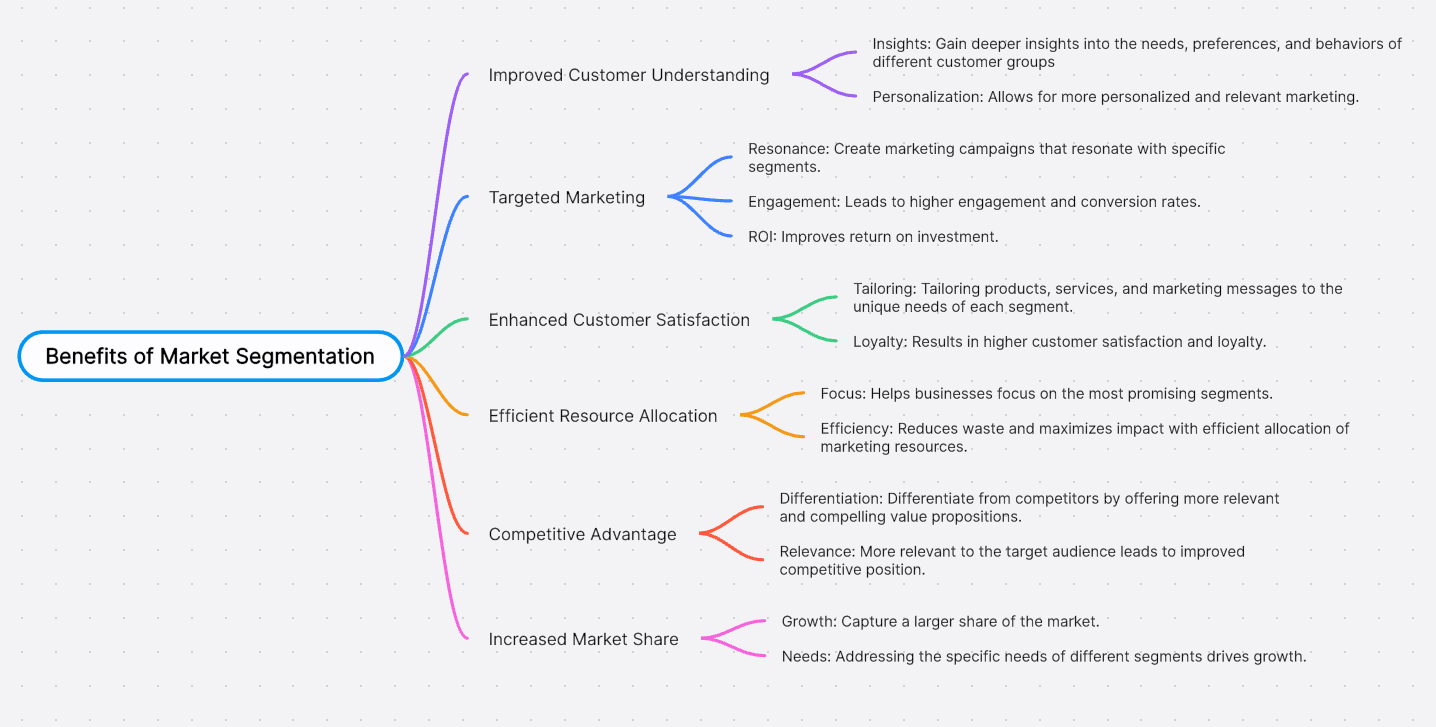
Improved Customer Understanding: By segmenting the market, businesses gain deeper insights into the needs, preferences, and behaviors of different customer groups, allowing for more personalized and relevant marketing.
Targeted Marketing: Segmentation enables companies to create targeted marketing campaigns that resonate with specific segments, leading to higher engagement, conversion rates, and return on investment (ROI).
Enhanced Customer Satisfaction: Tailoring products, services, and marketing messages to the unique needs of each segment results in higher customer satisfaction and loyalty.
Efficient Resource Allocation: Market segmentation example helps businesses allocate their marketing resources more efficiently by focusing on the most promising segments, reducing waste, and maximizing impact.
Competitive Advantage: Companies that effectively implement market segmentation can differentiate themselves from competitors by offering more relevant and compelling value propositions to their target audience.
Increased Market Share: By addressing the specific needs of different segments, businesses can capture a larger share of the market and drive growth.
Limitations of Market Segmentation
While the market segmentation example offers many advantages, it also has some limitations that businesses need to be aware of:
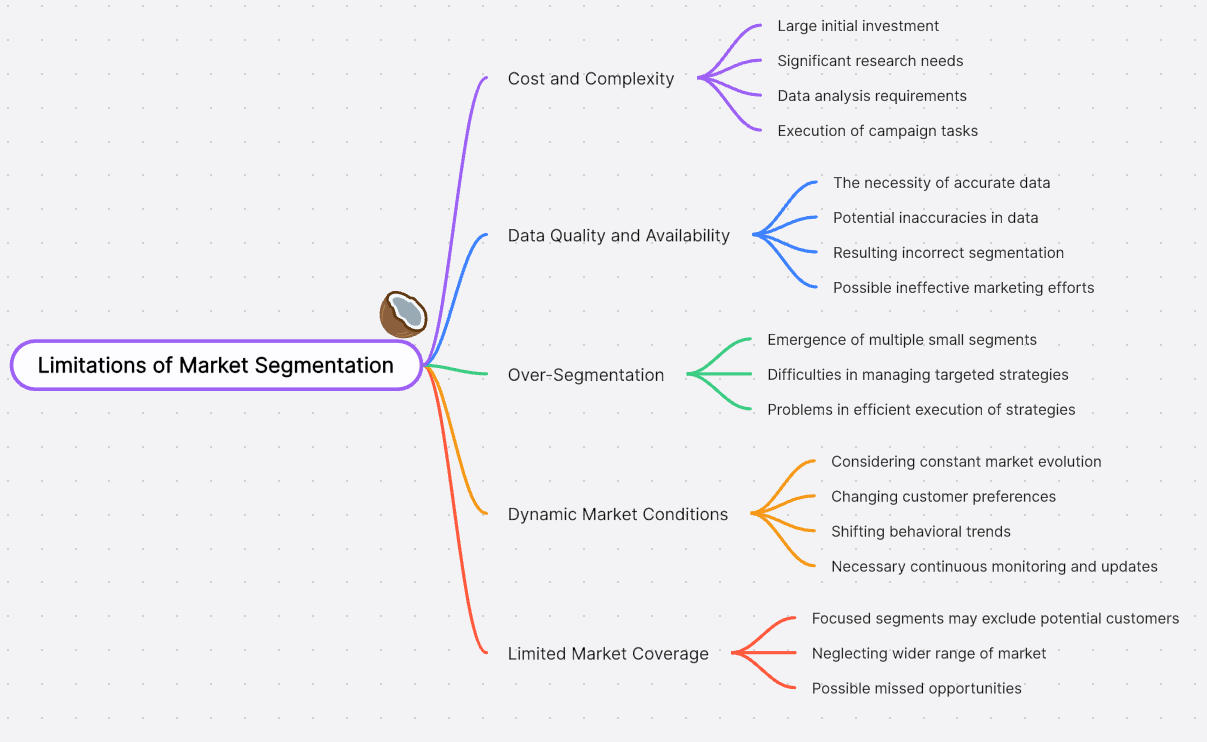
Cost and Complexity: Implementing a segmented marketing strategy can be costly and complex, requiring significant investment in research, data analysis, and campaign execution.
Data Quality and Availability: Accurate and reliable data is essential for effective segmentation. Incomplete or inaccurate data can lead to incorrect segmentation and ineffective marketing efforts.
Over-Segmentation: Over-segmenting the market can result in too many small segments, making it challenging to manage and execute targeted marketing strategies efficiently.
Dynamic Market Conditions: Markets are constantly evolving, and customer preferences and behaviors can change over time. Businesses need to continuously monitor and update their segmentation strategies to stay relevant.
Limited Market Coverage: Focusing on specific segments may lead to neglecting other potential customers, resulting in missed opportunities.
Market segmentation example is a powerful tool that enables businesses to understand their target audience better, create tailored marketing strategies, and enhance customer satisfaction. By dividing a broad market into smaller, more manageable segments, companies can address the unique needs of different customer groups and achieve greater marketing efficiency and effectiveness. With the right approach, market segmentation can unlock new opportunities for growth and success.
By following this guide and leveraging free templates and tools available online, businesses can effectively implement market segmentation strategies to drive better results and gain a competitive edge in their respective industries.













